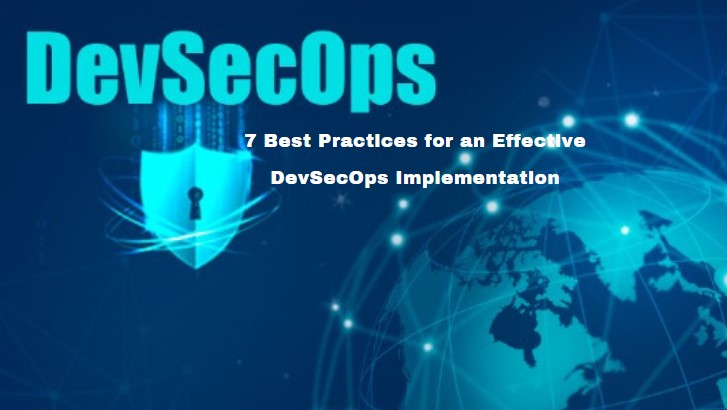DevSecOps includes security practices in the DevOps approach. Many companies who want to incorporate security into their DevOps channels should accept tools and practices that unite the application evolution, QA testing, IT operations, and security teams under the familiar DevSecOps title.
The DevSecOps model summons for security incorporation from the beginning and also along the method chain till the close. This strategic move in incorporating security controls in the Software Development Lifecycle [SDLC] has made a vast transformation to the IT industry in delivering quick, yet secure code. However, effective security incorporation into the DevSecOps channels through DevSecOps needs the acceptance of possible resources, tools, and practices that can connect Dev, Ops, and Security teams under the sphere of DevSecOps values.
Mentioned below are the best practices that can be applied for productive DevSecOps implementation!
1# Automation is vital to securing the CI/CD pipeline
One of the vital features of Continuous Integration [CI] and Continuous Deployment [CD] is the speedy delivery in DevOps. Therefore, assimilating the security in this quick-paced environment needs automation security and implanting applicable tests and controls across the expansion lifecycle. Automated tools can also assist you in identifying security risks, but they should be utilized wisely. When the automated security analysis is added to the CI/CD channels, it puts a stop to the initial entry of vulnerabilities and maintains the code secure through the evolved lifecycle.
2# Identify prospective vulnerabilities and address code dependencies
Reflecting upon the likely vulnerabilities connected with open-source usage, it is significant to comprehend the open-source practice for an effective DevSecOps strategy. Also, there should be a committed automated process for handling the open-source and third-party software elements. These processes aid in the early identification of possible open-source related vulnerabilities, hence lessening the impact on internal code dependencies. Thus, checking code dependency is vital to DevSecOps implementation.
3# Selecting the right security tools is very significant
Choosing the right security tools is vital for the accomplishment of your DevSecOps process which should be blended effortlessly into the quick-moving CI/CD cycles and also, form the gaps between security teams and development. These tools should be decent in speed and also, produce ideal and valuable results without rechecking by security teams that are the key factor in the DevOps workflow. Security tools should not only identify the vulnerabilities but even track the unknown issues from anywhere like open-source software modules.
4# Training on secure coding is important
It is important to train the developers properly to deliver the secure code rightly as it stands as one of the vital challenges to fruitful execution of DevSecOps practices. Though it might not be their priority to the team, gaining security in DevOps principles calls for the need to make the developers mindful of security-related statistics. Companies require making needful steps and also make necessary investments in the training area of secure coding for the productive execution of DevSecOps.
5# Allow the developers to familiarize with the security checks
The developers should get themselves accustomed to the security checking in their normal workflow. SAST tools are distinct to this case as they let the developers scan the code for any probable security checks during that they write as well as provide them feedback instantly, which is a part of the workflow of developers. Thus, it is suggested to set one or two security checks at one time and allow the developers to understand that the security rules are even a segment of their process.
6# Threat modeling mechanism implementation

It is significant to implement the mechanism of threat modeling in the DevOps lifecycle as it assists the developers in seeing the software from the perceptive of the attacker. Therefore, the developers will be very careful in writing the code and also can produce a secure code. Threat assessment aids you in comprehending the sensitivities of internal assets and their exposure to probable threats. It also assists you in identifying the probable vulnerabilities in your architecture as well as design. Though threat modeling is a crucial part of accomplished security integration, it slows the pace of your CI/CD pipeline and can’t be automated either.
7# Risk management of technologies and third-party tools
The rise is the high usage of open-source technologies for the development of an application. It is believed that open-source technology is evaluative. Thus, the security concerns across the open technologies’ usage must be addressed properly. The developers are up to reviewing the open-source codes that might lead to unidentified exposures and other security problems and issues on the codes. Thus, the code dependency is essential. To have a check of OWASP utility will make sure that there isn’t any exposure in the codes that are reliable on the open-source elements.
Conclusion
The aim of DevSecOps is to make the security portion of the software workflow grow, along with better coding of safe coding and testing automation. The above practices are the key to the success of DevSecOps implementation in your businesses so that you can apply and gain productive outputs!
Sanghamitra Roychoudhary
Latest posts by Sanghamitra Roychoudhary (see all)
- 8 Top Challenges of Cyber Security in the Digital Age - April 27, 2024
- 7 Best Practices for an Effective DevSecOps Implementation - April 26, 2024
- Top Impacts of IoT on Businesses - July 21, 2023

